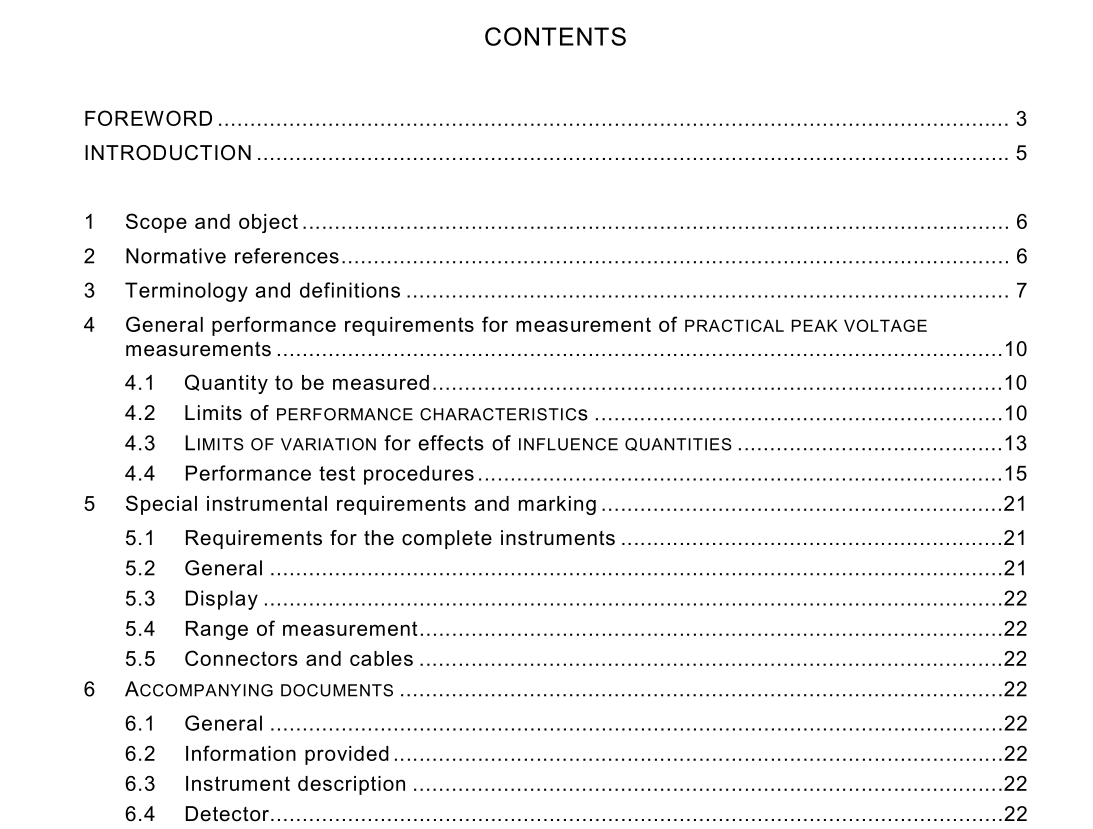IEC 61676 pdf download

IEC 61676 pdf download.Medical electrical equipment – Dosimetric instruments used for non-invasive measurement of X-ray tube voltage in diagnostic radiology
1 Scope and object
This International Standard specifies the performance requirements of instruments as used in the NON – INVASIVE MEASUREMENT of X- RAY TUBE VOLTAGE up to 150 kV and the relevant compliance tests. This standard also describes the method for calibration and gives guidance for estimating the uncertainty in measurements performed under conditions different from those during calibration. Applications for such measurement are found in diagnostic RADIOLOGY including mammography, COMPUTED TOMOGRAPHY (CT), dental radiology and RADIOSCOPY . This standard is not concerned with the safety aspect of such instruments. The requirements for electrical safety applying to them are contained in IEC 61010-1.
2 Normative references
The following referenced documents are indispensable for the application of this document. For dated references, only the edition cited applies. For undated references, the latest edition of the referenced document (including any amendments) applies. IEC 60417 (all parts), Graphical symbols for use on equipment IEC 60788:1984, Medical radiology – Terminology IEC 61000-4-2:1995, Electromagnetic compatibility (EMC) – Part 4: Testing and measurement techniques – Section 2: Electrostatic discharge immunity test. Basic EMC Publication IEC 61000-4-3:2000, Electromagnetic compatibility (EMC) – Part 4-3: Testing and measure- ment techniques – Radiated, radio-frequency, electromagnetic field immunity test. Basic EMC Publication IEC 61000-4-4:1995, Electromagnetic compatibility (EMC) – Part 4: Testing and measurement techniques – Section 4: Electrical fast transient/burst immunity test. Basic EMC Publication IEC 61000-4-5:1995, Electromagnetic compatibility (EMC) – Part 4: Testing and measurement techniques – Section 5: Surge immunity test. Basic EMC Publication IEC 61000-4-6:1996, Electromagnetic compatibility (EMC) – Part 4: Testing and measurement techniques – Section 6: Immunity to conducted disturbances, induced by radio frequency fields. Basic EMC Publication
3 Terminology and definitions
For the purposes of this standard the following definitions apply. The definitions given in this standard are generally in agreement with those in IEC 60788 and the ISO International vocabulary of basic and general terms in metrology. Any terms not defined in this subclause have the meanings defined in the above publications or are assumed to be in general scientific usage. 3.1 CORRECTION FACTOR dimensionless multiplier which corrects the INDICATED VALUE of an instrument from its value when operated under particular conditions to its value when operated under stated REFERENCE CONDITIONS 3.2 EFFECTIVE RANGE range of INDICATED VALUES for which an instrument complies with a stated performance. The maximum (minimum) effective INDICATED VALUE is the highest (lowest) in this range 3.3 INDICATED VALUE the value of quantity derived from the scale reading of an instrument together with any scale factors indicated on the control panel of the instrument 3.4 INFLUENCE QUANTITY any external quantity that may affect the performance of an instrument (e.g. ambient temperature etc.) and any property of the X- RAY EQUIPMENT under test that needs to be taken into account in using the instrument for NON – INVASIVE MEASUREMENT of X- RAY TUBE VOLTAGE (e.g. range of X- RAY TUBE VOLTAGE , ANODE ANGLE , anode material, TOTAL FILTRATION etc.) 3.5 INSTRUMENT PARAMETER any internal property of an instrument that may affect the performance of the instrument 3.6 INTRINSIC ERROR deviation of the MEASURED VALUE (i.e. the INDICATED VALUE , corrected to REFERENCE CONDITIONS ) from the CONVENTIONAL TRUE VALUE under STANDARD TEST CONDITIONS 3.7 INVASIVE MEASUREMENT measurement of the X – RAY TUBE VOLTAGE by external connection of a suitable meter or a high resistance divider3.17 RATED RANGE (of use) the range of values of an INFLUENCE QUANTITY or INSTRUMENT PARAMETER within which the instrument will operate within the LIMITS OF VARIATION . Its limits are the maximum and minimum RATED values. The MINIMUM RATED RANGE is the least range of an INFLUENCE QUANTITY or INSTRUMENT PARAMETER within which the instrument shall operate within the specified LIMITS OF VARIATION in order to comply with this standard 3.18 REFERENCE CONDITIONS conditions under which all INFLUENCE QUANTITIES and INSTRUMENT PARAMETERS have their REFERENCE VALUES 3.19 REFERENCE VALUE particular value of an INFLUENCE QUANTITY (or INSTRUMENT PARAMETER ) chosen for the purposes of reference i.e. the value of an INFLUENCE QUANTITY (or INSTRUMENT PARAMETER ) at which the CORRECTION FACTOR for dependence on that INFLUENCE QUANTITY (or INSTRUMENT PARAMETER ) is unity 3.20 RELATIVE INTRINSIC ERROR the ratio of the INTRINSIC ERROR to the CONVENTIONAL TRUE VALUE 3.21 RESPONSE the quotient of the INDICATED VALUE divided by the CONVENTIONAL TRUE VALUE 3.22 STANDARD TEST CONDITIONS conditions under which all INFLUENCE QUANTITIES and INSTRUMENT PARAMETERS have their STANDARD TEST VALUES









